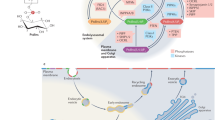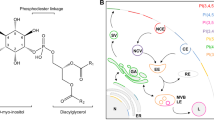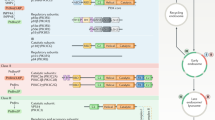Overview
- Editors:
-
-
Tamas Balla
-
, NICHD, National Institutes of Health, Bethesda, USA
-
Matthias Wymann
-
, Cancer- and Immunobiology, University of Basel, Basel, Switzerland
-
John D. York
-
, Pharmacology and Cancer Biology, Duke University Medical Center, Durham, USA
- In depth discussion of the state of the art of phosphoinositide research
- Experts in the field discussing the 'hot' topics in phosphoinositide research
- A volume dedicated to processes regulated by phosphoinositides
- Includes supplementary material: sn.pub/extras
Access this book
Other ways to access
About this book
Phosphoinositides play a major role in cellular signaling and membrane organization. During the last three decades we have learned that enzymes turning over phosphoinositides control vital physiological processes and are involved in the initiation and progression of cancer, inflammation, neurodegenerative, cardiovascular, metabolic disease and more. In two volumes, this book elucidates the crucial mechanisms that control the dynamics of phosphoinositide conversion. Starting out from phosphatidylinositol, a chain of lipid kinases collaborates to generate the oncogenic lipid phosphatidylinositol(3,4,5)-trisphosphate. For every phosphate group added, there are specific lipid kinases – and phosphatases to remove it. Additionally, phospholipases can cleave off the inositol head group and generate poly-phosphoinositols, which act as soluble signals in the cytosol.
Volume II extends into the role of phosphoinositides in membrane organization and vesicular traffic. Endocytosis and exocytosis are modulated by phosphoinositides, which determine the fate and activity of integral membrane proteins. Phosphatidylinositol(4,5)-bisphosphate is a prominent flag in the plasma membrane, while phosphatidylinositol-3-phosphate decorates early endosomes. The Golgi apparatus is rich in phosphatidylinositol-4-phosphate, stressed cells increase phosphatidylinositol(3,5)-bisphosphate, and the nucleus has a phosphoinositide metabolism of its own. Phosphoinositide-dependent signaling cascades and the spatial organization of distinct phosphoinositide species are required in organelle function, fission and fusion, membrane channel regulation, cytoskeletal rearrangements, adhesion processes, and thus orchestrate complex cellular responses including growth, proliferation, differentiation, cell motility, and cell polarization.
Similar content being viewed by others
Table of contents (14 chapters)
-
-
- Colin W. Taylor, David L. Prole
Pages 1-34
-
- Amber L. Schuh, Anjon Audhya
Pages 35-63
-
- Peter J. Cullen, Jeremy G. Carlton
Pages 65-110
-
-
- Samuel G. Frere, Belle Chang-Ileto, Gilbert Di Paolo
Pages 131-175
-
- Li Zhang, Yuntao S. Mao, Paul A. Janmey, Helen L. Yin
Pages 177-215
-
- Michael C. Weiger, Carole A. Parent
Pages 217-254
-
- Giovanni D’Angelo, Mariella Vicinanza, Cathal Wilson, Maria Antonietta De Matteis
Pages 255-270
-
- Carl J. Mousley, James M. Davison, Vytas A. Bankaitis
Pages 271-287
-
- Nikita Gamper, Tibor Rohacs
Pages 289-333
-
- Roberta Fiume, Willem Jan Keune, Irene Faenza, Yvette Bultsma, Giulia Ramazzotti, David R. Jones et al.
Pages 335-361
-
- Bernard Payrastre, Frédérique Gaits-Iacovoni, Philippe Sansonetti, Hélène Tronchère
Pages 363-388
-
- Stephen B. Shears, Sindura B. Ganapathi, Nikhil A. Gokhale, Tobias M. H. Schenk, Huanchen Wang, Jeremy D. Weaver et al.
Pages 389-412
-
-
Back Matter
Pages 439-439
Editors and Affiliations
-
, NICHD, National Institutes of Health, Bethesda, USA
Tamas Balla
-
, Cancer- and Immunobiology, University of Basel, Basel, Switzerland
Matthias Wymann
-
, Pharmacology and Cancer Biology, Duke University Medical Center, Durham, USA
John D. York




